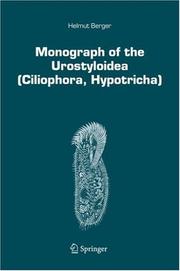| Listing 1 - 2 of 2 |
Sort by
|

ISBN: 1280864915 9786610864911 1402052731 1402052723 Year: 2006 Volume: v. 85 Publisher: Dordrecht, the Netherlands : Springer,
Abstract | Keywords | Export | Availability | Bookmark
 Loading...
Loading...Choose an application
- Reference Manager
- EndNote
- RefWorks (Direct export to RefWorks)
This monograph is the second of a series treating the hypotrichs, a major part of the spirotrichous ciliates. The urostyloids are characterised by a zigzag-arrangement of the ventral cirri. Like the first part of the series, the Oxytrichidae, it summarises the morphological, morphogenetic, faunistic, and ecological data from the past 230 years, scattered in more than 1300 references from all over the world. Dichotomous keys lead to 36 genera and subgenera comprising 153 species illustrated by more than 2100 figures, including original ones. The treatise offers taxonomists, cell biologists, and
Hypotrichida --- Hypotricha --- Hypotrichia --- Hypotrichina --- Hypotrichorida --- Hypotrichous ciliates --- Hypotrichs --- Spirotricha --- Invertebrates. --- Aquatic biology. --- Zoology. --- Freshwater & Marine Ecology. --- Animal Systematics/Taxonomy/Biogeography. --- Biology --- Natural history --- Animals --- Hydrobiology --- Water biology --- Aquatic sciences --- Invertebrata --- Aquatic ecology . --- Animal systematics. --- Animal taxonomy. --- Animal classification --- Animal systematics --- Animal taxonomy --- Classification --- Systematic zoology --- Systematics (Zoology) --- Taxonomy, Animal --- Zoological classification --- Zoological systematics --- Zoological taxonomy --- Zoology --- Aquatic biology --- Ecology
Book
ISBN: 9781402089176 1402089163 9781402089169 1402089171 9400792816 Year: 2008 Publisher: [Dordrecht] : Springer,
Abstract | Keywords | Export | Availability | Bookmark
 Loading...
Loading...Choose an application
- Reference Manager
- EndNote
- RefWorks (Direct export to RefWorks)
This book is the third of six volumes which review the Hypotricha, a major group of the spirotrichous ciliates. It is about the Amphisiellidae, the Trachelostylidae, and some genera of unknown position in the Hypotricha. Further, it comprises supplements to the Oxytrichidae and the Urostyloidea. The Amphisiellidae are characterised by a more or less distinct ventral file, termed amphisiellid median cirral row. They produce their frontal-ventral-transverse cirri from six anlagen, a feature taken over from the ground pattern of the Hypotricha. Trachelostyla, the eponymous type of the Trachelostylidae, is an 18-cirri hypotrich, which lacks – like the amphisiellids – dorsomarginal kineties. The lack of these kineties indicates that both taxa branch off rather early in the hypotrich tree. The core amphisiellids (e.g., Amphisiella, Spiroamphisiella) and the trachelostylids are confined to marine habitats. By contrast, the other genera reviewed in this volume (e.g., Lamtostyla, Hemisincirra) are mainly terrestrial. A total of 89 species, distributed in 27 genera, are revised in detail, that is, almost all morphological, ontogenetic, faunistic, and ecological data, scattered in almost 600 papers are summarised. With the monographs of the Oxytrichidae, the Urostyloidea, and the Amphisiellidae and Trachelostylidae the interested scientist can identify more than 410 species of hypotrichs. The treatise offers taxonomists, cell biologists, ecologists, molecular biologists, and practitioners a thorough and up-to-date overview about this highly interesting group of ciliates.
Life Sciences. --- Zoology. --- Ecology. --- Life sciences. --- Sciences de la vie --- Ecologie --- Zoologie --- Ciliata -- Classification. --- Ciliata. --- Hypotrichida -- Classification. --- Hypotrichida. --- Zoology --- Health & Biological Sciences --- Invertebrates & Protozoa --- Zoology - General --- Hypotrichida --- Ciliata --- Trachelostylidae --- Amphisiellidae --- Amphisiellids --- Trachelostylids --- Ciliated protozoa --- Ciliophora --- Hypotricha --- Hypotrichia --- Hypotrichina --- Hypotrichorida --- Hypotrichous ciliates --- Hypotrichs --- Protozoa --- Spirotricha --- Biology --- Natural history --- Animals --- Balance of nature --- Bionomics --- Ecological processes --- Ecological science --- Ecological sciences --- Environment --- Environmental biology --- Oecology --- Environmental sciences --- Population biology --- Ecology --- Ecology .
| Listing 1 - 2 of 2 |
Sort by
|

 Search
Search Feedback
Feedback About UniCat
About UniCat  Help
Help News
News